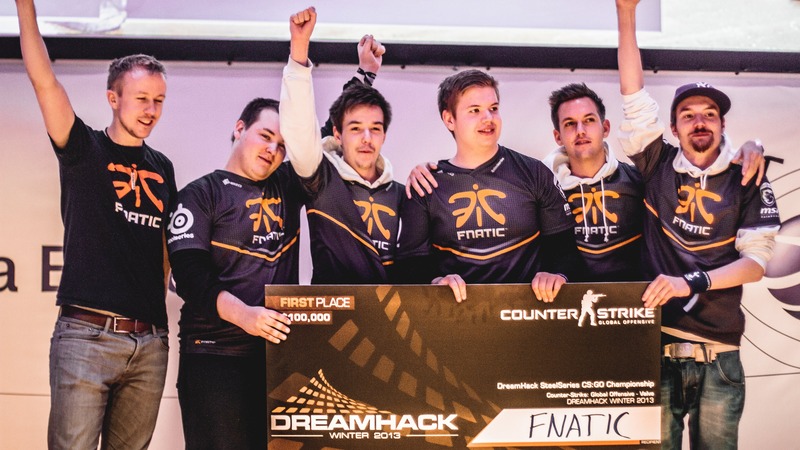CS:GO Majors are the biggest event in the esports calendar, and attract the attention of all fans, casual and hardcore. We want to take a trip back in time, to see how the Majors have evolved since their inception in 2013.
The first-ever CS:GO Major winners. Credit: Fnatic on Twitter
The Dawn Of CS:GO Majors
In the beginning, there was Jönköping. DreamHack Winter 2013 was fought in the Swedish city, ushering in a new era of competitive Counter-Strike.
Looking back, it’s surprising how much of the format is instantly recognizable. The most notable differences are in the game itself, and the updates received by Valve. It’s a massive trip down memory lane for long-term players of CS:GO. Let’s look back at the first-ever Grand Final between NIP and Fnatic, to see where it all began.
If there’s one word to describe the biggest differences, it’s “scale.” Everything is smaller in scale, from the stage to the prize fund. You won’t find many calling it the best CS:GO Major ever, but it has the right idea.
It almost seems impossible for CS:GO Major winners to be crowned in a tiny hall in front of around 100 people, but that’s the reality of the scene back in 2013. They even had fewer teams, with 16 compared to the modern 24 competing for a $250,000 prize pool. It’s not a small reward by any means, but compared to some of the numbers floated today, it seems like a pittance.
It’s fun to look back and see that despite all the changes, there are some familiar teams and players. Teams like NIP, Fnatic, and NAVI remain mainstays, while players such as dupreeh, karrigan, and dev1ce all still compete at the top of the game.
ELEAGUE Major Boston 2018
Five years into the CS:GO Majors, we had ELEAGUE Major Boston 2018. Filled with many memorable moments, some consider it to be the best CS:GO Major of all time. It had drama right down to the wire, with Stewie2k’s 4k to take the Grand Final to overtime being some of the top CS:GO Major kills in history.
Comparing Jönköping and Boston’s Grand Finals, it’s easy to see the immediate jump in production quality.
Even down to the microphone quality, you can see that the CS:GO Majors have become detail-oriented in an attempt to be taken seriously. It certainly pays off, as thousands of people flooded to the Agganis Arena to cheer on their favorite teams. With a prize pool of $1,000,000 on the line, the stakes were far higher than ever before. Boston was certainly less of a creep-up in quality, and more of a leap.
Despite the jump in quality, there are clearly still some kinks being worked out here. The main one is the sponsorships. 2018 was an era with a strange conundrum. Companies wanted to get in early on the potentially-lucrative esports pie, while teams and tournaments were still figuring out how to make esports financially viable for themselves. The result is an odd mash-up of sponsorships, jumping from Boost Mobile, to Alienware, to Cheez-It Grooves, to… the U.S Air Force? There was just no consistency to it. As bizarre as it seems, it’s understandable that early on the scene, tournaments and teams had to take whatever sponsor they could to survive. The ends justify the means.
At this point, many of the ever-present teams in the modern game had established themselves as contenders, with Liquid, FaZe, Cloud9, NAVI, G2, Astralis, and Virtus.pro all present, among others.
The Modern Major
Before the CS:GO Paris Major, there was the IEM Rio Major 2022. Arguably the best CS:GO Major in terms of production quality, this is where we see the leap to being a truly world-class display. There may not have been many CS:GO Major records set on the server in Rio, but there’s no denying off the server the standards have never been higher.
There’s a lot to digest by comparing the Boston Grand Final to Rio.
One thing that’s immediately noticeable is the quality of the commentators. CS:GO is uniquely blessed with an abundance of the best casting talent in esports, and it peaked in Rio. The commentators were always great, even at Dreamhack Winter 2013, but give those guys 9 years of experience on top of that and you’ve got a recipe for success.
It’s interesting to see how CS:GO Majors have focused on the viewer experience over the years. The overlay is so clean, the sleek and modern to Boston’s clunky and aged. It’s something that even a casual CS:GO player could grasp, a big reason that the scene continues to attract more players every single day.
Of course, we can’t discuss Rio without talking about the s-word again. Scale. Rio was huge. A 7,000 capacity in Boston pales in comparison to the 18,000 capacity Jeunesse Arena, a symbol of the enormous progress this scene has undergone in recent years.
We can look forward to many more years of progress, and the CS:GO Paris Major so far is the perfect example of that.


Deixar um comentário